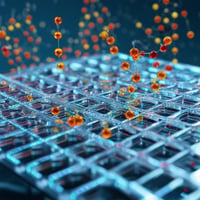The impact of massive multiplexing on drug development is transformative. Historically, drug...
Breaking the Single Cell Bottleneck with ScalePlex
As researchers hunger to explore more cellular landscapes, the traditional scRNA-seq workflow becomes a financial and logistical labyrinth. More samples mean exponentially rising costs, more complex protocols, and diminishing returns. It's like wanting to understand an entire ecosystem but being constrained to studying just a few square meters. Enter a groundbreaking multiplexing kit that shatters these limitations. This technological breakthrough doesn't just incrementally improve research – it reimagines what's possible. By scaling sample throughput from dozens to potentially thousands of samples, researchers can now map cellular diversity with unprecedented breadth and depth.
How ScalePlex Works
ScalePlex is a fixation enabled method of multiplexing that utilizes numerous sets of 96 tags to massively scale up sample throughput with a convenient, streamlined workflow. By leveraging a large sample pooling strategy combined with the standard 96 sample input to ScaleBio’s scRNA-seq workflows, the platform enables massive multiplexing up to 9,216 samples (96 ScalePlex tags x 96 RT barcodes) with a significant reduction in tedious and time-consuming workflow steps.
ScalePlex tags are proprietary modified oligos, designed to be compatible with single cell RNA sequencing on Scale Bio platforms. Tags attach to the cell or nucleus during fixation, and leverages the same massively parallelized barcoding technology to barcode the tags alongside the RNA library.

Figure 1: Overview of ScalePlex tagging and library preparation workflow
A: Proprietary ScalePlex oligos attach to the cell or nucleus during fixation, locking in sample biology and ScalePlex tag identity. B: Up to 96 samples can be combined into a single tube requiring only one wash step per 96 samples. C: ScalePlex oligos are designed to barcode alongside mRNA, ensuring traceability between the RNA library and ScalePlex library. D: Each cell is assigned to a ScalePlex oligo when demultiplexing using the ScaleBio Seq Suite: RNA Bioinformatics pipeline, allowing for thousands of samples to be uniquely identified by RT barcode and ScalePlex tag.
From Dozens to Thousands: Unleashing True High-Throughput Analysis
Other high throughput methods impose physical limitations on throughput by processing individual samples in a single 96 well plate, or only allow for small sample pools of up to 16 tags. The ability to combine 96 samples into a single representative sample pool increases the number of samples that can be multiplexed with a significantly more streamlined workflow.
This comparison demonstrates the workflow strain that is removed when handling 96 samples at a time rather than pools of 16. Pooling more samples reduces washing and counting steps, saving time and enhancing cell recovery.

Figure 2: Sample preparation of 96 samples with ScalePlex vs smaller pools of probes
One Solution, Endless Possibilities
Compared to antibodies and probes, ScalePlex is species-agnostic and can be used broadly across experiments without the need for optimization or titration. ScalePlex oligos can be used as you need them, when you need them. Whether the experiment requires hundreds of banked samples or isolating a few nuclei samples per day, the oligos can be thawed and frozen to use at any pace, with a fixation-enabled workflow to lock in biology.
.png?width=1200&length=1200&name=image%20(8).png)
Figure 3: Comparison of workflow steps for preparation of 96 samples across platforms
ScalePlex multiplexing takes significantly less time than other methods with materials ready out of the box and streamlined washing and counting steps.
Built for Discovery: Where Power Meets Precision
ScalePlex is compatible with all ScaleBio 3’ RNA sequencing platforms including the current scRNA v1.1 kit as well as the next generation QuantumScale platform, ensuring high sensitivity and ideal for discovery of novel transcripts, without sacrificing on multiplexing potential and streamlined library preparation. This technology is compatible with genetic demultiplexing methods, providing additional advantage for deeper discovery over other probe-based methods.
Accelerating Tomorrow's Breakthroughs, Today
ScalePlex fixation is compatible with both the Single Cell RNA Sequencing Kit v1.1 and QuantumScale RNA Sequencing, ensuring seamless integration into existing research workflows. This thoughtful design means laboratories can immediately leverage the technology without extensive retooling or retraining.
ScalePlex technology represents more than just an incremental advancement. As researchers generate more sophisticated, large-scale cellular atlases, we move closer to truly personalized approaches in medicine, drug discovery, and our fundamental understanding of biological complexity. The future of biological research is not just about generating more data—it's about generating more meaningful, transformative insights.
Contact us





